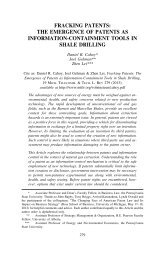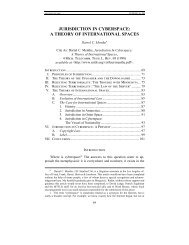the chinese regulatory licensing regime for pharmaceutical products
the chinese regulatory licensing regime for pharmaceutical products
the chinese regulatory licensing regime for pharmaceutical products
Create successful ePaper yourself
Turn your PDF publications into a flip-book with our unique Google optimized e-Paper software.
422 Michigan Telecommunications and Technology Law Review [Vol. 15:417<br />
requirements, <strong>licensing</strong> is conditioned upon having appropriate staff,<br />
facilities, and management systems. 29<br />
Sixth, be<strong>for</strong>e making medicinal preparations <strong>for</strong> patients, a medical<br />
organization must obtain prior approval from <strong>the</strong> Health Authority at <strong>the</strong><br />
provincial level, as well as a dispensing permit issued by a branch of <strong>the</strong><br />
SFDA at <strong>the</strong> same level. 30 To ensure quality, <strong>licensing</strong> is conditioned<br />
upon <strong>the</strong> organization’s facilities, management systems, and sanitation,<br />
as well as o<strong>the</strong>r requirements. 31<br />
Seventh, drugs cannot be imported into China without a Registration<br />
Certificate <strong>for</strong> Imported Drugs (“RCID”). 32 For a RCID to be issued,<br />
prospective importers generally must satisfy <strong>the</strong> SFDA criteria <strong>for</strong> safety<br />
and efficacy, but <strong>the</strong>y may be exempt if <strong>the</strong> drug is <strong>for</strong> emergency hospital<br />
use or individual use. 33 Additionally, be<strong>for</strong>e every importation, <strong>the</strong><br />
importer must obtain an imported drug customs clearance from an affiliate<br />
of <strong>the</strong> SFDA at <strong>the</strong> port designated <strong>for</strong> <strong>the</strong>ir drugs to enter China. 34<br />
The 2001 Drug Administration Law no longer imposes compulsory testing<br />
on imported drugs unless <strong>the</strong>y are entering China <strong>for</strong> <strong>the</strong> first time;<br />
however, a <strong>pharmaceutical</strong>s testing institute appointed by an affiliate of<br />
<strong>the</strong> SFDA will carry out selective testing on imported drugs after <strong>the</strong>y<br />
enter <strong>the</strong> Chinese market. 35<br />
Eighth, three kinds of <strong>pharmaceutical</strong>s—namely bio-<strong>products</strong> stipulated<br />
by <strong>the</strong> SFDA, drugs being sold <strong>for</strong> <strong>the</strong> first time in China, and o<strong>the</strong>r<br />
drugs stipulated by <strong>the</strong> State Council—must pass tests conducted by appointed<br />
institutes be<strong>for</strong>e being imported or marketed. 36 This compulsory<br />
testing (“a test pass license”) is a de facto <strong>licensing</strong> requirement. 37<br />
Lastly, no over-<strong>the</strong>-counter drug can be advertised in China unless<br />
<strong>the</strong> sponsor obtains an advertising license from a branch of <strong>the</strong> SFDA at<br />
<strong>the</strong> provincial level and an advertising permit from a branch of <strong>the</strong> State<br />
Industry and Commerce Administration at <strong>the</strong> county level or above. 38<br />
Only medicinal and <strong>pharmaceutical</strong> journals, jointly-authorized by <strong>the</strong><br />
Health Authority under <strong>the</strong> State Council and <strong>the</strong> SFDA, can carry ad-<br />
29. Id. art. 15.<br />
30. Id. art. 23.<br />
31. Id. art. 24.<br />
32. Id. art. 39.<br />
33. Id.<br />
34. Id. art. 40.<br />
35. Id. arts. 40–41.<br />
36. Id. art. 41.<br />
37. Id.<br />
38. See id. art. 60; Advertisement Law (promulgated by <strong>the</strong> Standing Comm. Nat’l<br />
People’s Cong., Oct. 27, 1994, effective Feb. 1, 1995) art. 34 (P.R.C.).






